| Home | About Us | Resources | Archive | Free Reports | Market Window |
What You're Not Hearing About Oil StocksBy
Thursday, January 15, 2015
It's one of the biggest questions in the market right now... And we're worried lots of people are getting the answer wrong.
The question: Is it time to buy oil stocks yet?
In late July, we warned DailyWealth Traders that crude oil was due for a decline. We pointed out that sentiment (as measured by fund-manager positions) was extremely bullish toward oil, which is a bearish signal.
Since our warning, oil has crashed. It's fallen from $102 per barrel to $45 per barrel. As contrarian traders who hunt for crisis situations, oil has been on our radar...
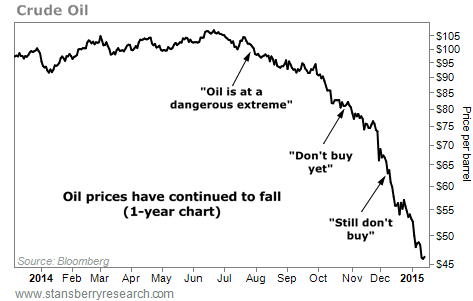 Some folks are already buying oil stocks. They believe they've hit bottom. For example, top financial weekly Barron's recently ran a cover story that encouraged readers to buy a handful of oil stocks. Many of the talking heads on financial television say they're buying oil stocks. Other than buying them for a very short-term bounce (like 1-2 weeks), we recommend NOT buying oil stocks right now. There's a great chance some "sandpapering" is on the way.
And it's important that you know what sandpapering is...
In June 2013, we published an essay in DailyWealth Trader on "The Guillotine and the Sandpaper." In the essay, we explained the idea...
In other words, the guillotine is what happens when a market suffers a sharp selloff in a short time... and sets up an opportunity to trade a recovery. But before the recovery takes place, the asset often spends months or years moving sideways. That's the frustrating sandpaper phase. It's just how the market works. Consider our huge winning trade on aluminum giant Alcoa. In 2011, Alcoa suffered a near-50% drop. Instead of rebounding quickly, it "sandpapered" shareholders for two years. We waited... and jumped in right as the sandpapering ended. We made 80% in less than a year. You can see sandpaper phase in the chart of Alcoa below:
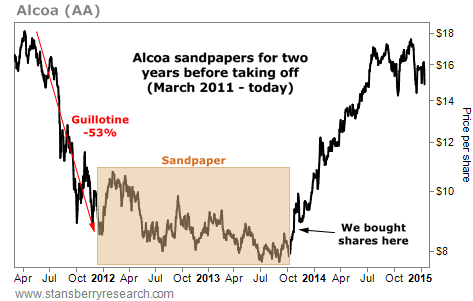 Or... consider airline stocks over the past four years. In 2011, airline stocks suffered a huge 45% drop. And while they ended up recovering and running higher, they spent more than 15 months trading sideways. They spent more than 15 months "sandpapering" traders who bought right after the drop. Then in late 2012, airline stocks started moving higher. You can see that sandpaper phase in the chart of leading airline Southwest Airlines.
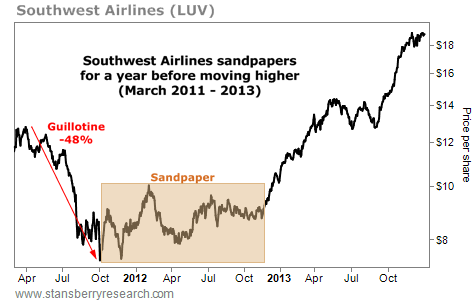 Again, sandpapering after the guillotine strike is usually how the market works. It takes time to absorb the shock of lower prices and form a bottom. And since many folks are still bullish on oil stocks today, we believe they'll trade sideways (or even lower) for at least several months. It could take more than a year for the sector to digest its huge recent loss... and frustrate the people who just bought shares.
You can see the guillotine in this two-year chart of the Dow Jones U.S. Oil & Gas stock index...
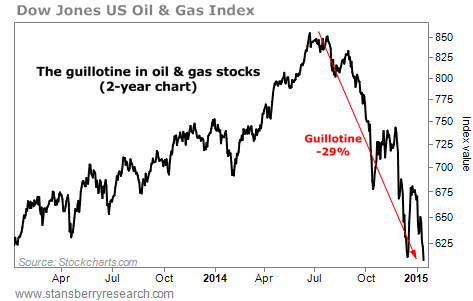 Now that oil stocks have suffered the guillotine strike, expect a sandpaper phase. The vast new supply of oil from North American fracking should keep prices below $60 for years. These lower prices will start filtering through oil-company income statements and balance sheets. Companies will report much lower asset values. They'll start reporting shockingly low earnings. Some of the companies that have taken on lots of debt will go bankrupt. We're sure a few companies will be busted for questionable accounting and overstating reserves (it always happens after major tops).
There will be a relentless supply of bad news from this sector... which will keep the investment public away.
Of course, we can't know how long the oil sector will take to frustrate the people who just bought in. But it's likely to be at least six months. We're sure experienced short-term traders (like our friend and colleague Jeff Clark) will be able to trade short-term rallies. But for traders and investors with longer time horizons, it's best to avoid oil stocks right now. They're due for a sandpaper phase.
When oil stocks finally rally, the gains could be enormous. But it's best to stand aside right now. We're monitoring the sector closely... And we'll update you as it plays out.
But for now, we'd much rather focus on sectors that will benefit from consumers paying less for gasoline... Stay tuned for more on this idea.
Regards,
Brian Hunt and Ben Morris
Further Reading:
Steve Sjuggerud says "you want to be a buyer of oil stocks AFTER everyone has given up on them." Learn when Steve expects to recommend buying oil stocks here: Why You Can't Buy Oil Stocks – Yet.
If you're going to trade "real assets" like oil, gold, and uranium, you must learn to master the resource market's cyclicality. Learn how in this interview with resource legend Rick Rule.
Market NotesAS EXPECTED, GOPRO SUFFERS A BIG DECLINE One of America's most popular stocks just got creamed... and DailyWealth readers shouldn't be surprised.
Back in September, we wrote a bearish note on GoPro, the innovative video-camera company. GoPro makes durable cameras you can attach to a helmet, a car, a surfboard, or even a dog. After going public last year, GoPro became one of the country's most popular stocks.
GoPro was so popular that investors bid the company to the sky-high crazy valuation of 10 times sales. We noted this overvaluation and said, "this expensive stock will suffer a huge correction soon." Shares were trading for $93.
As you can see from the chart below, our call was well-timed. GoPro has steadily declined since our note. And just yesterday, it was reported that Apple may soon be a GoPro competitor. The stock dropped nearly 10% to $52 per share and struck a multi-month low.
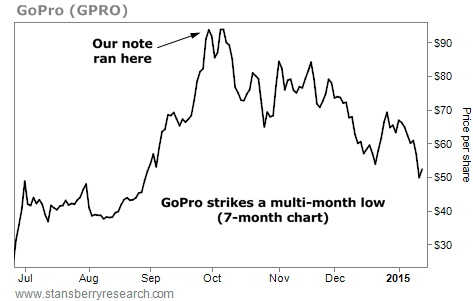 |
Recent Articles
|



